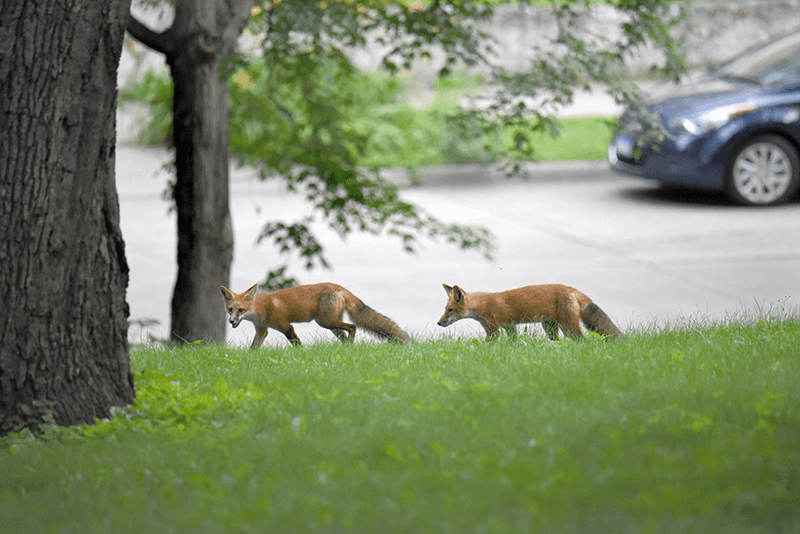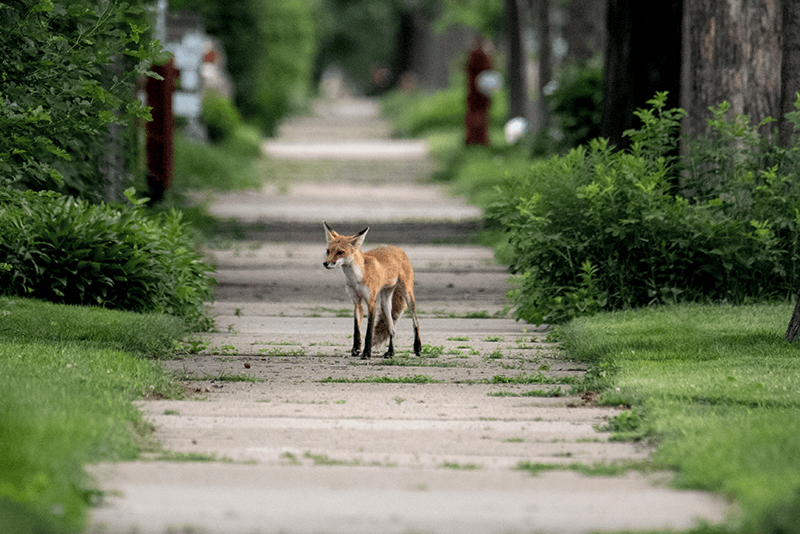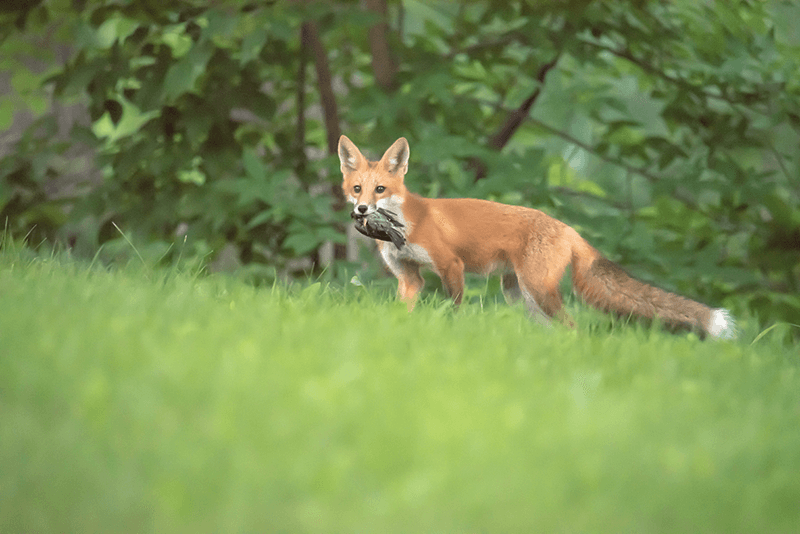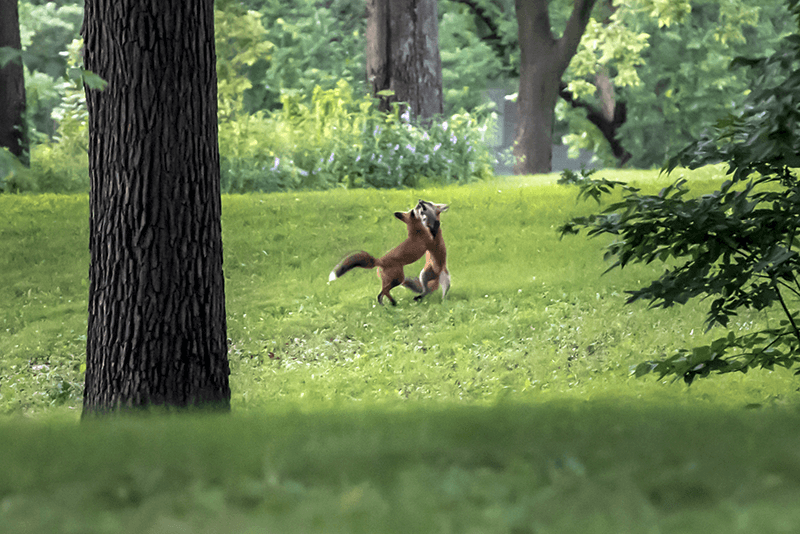Julie Conrad and Richard Clement get their daily fox fix at a Northeast park near their house, where there’s been a den over the years. It’s part of their evening walk.
At dusk, the faces of kits pop up in the brush; the whole family of foxes hangs out in a yard near their den. A couple of years ago, three foxes played in the grass with as many as 10 people watching, Conrad said.
At that same park, in early July, I watched two kits wrestle and chase each other until one of the parents spied me and barked like a dog to urge them into the brush. Early the next morning, it looked like hunting training. The young ones were less focused on each other and more on robins and squirrels, although none made a successful grab. One kit stood on its hind legs and pawed at the branches of a small evergreen tree.
Sightings and habitat
That family is not the only fox family in Northeast. When we put out a Facebook call for sightings, more than three dozen people responded, some publicly, others privately, afraid that sharing the information might lead to disturbing the foxes. It’s in that spirit that I won’t pinpoint locations here, particularly of dens.
But I will tell you about the types of places where I and other Northeast residents see them. They seem to be living in heavy brush and small stands of trees, near fields and other open areas, such as parks and railroad tracks.
It’s called “edge habitat,” said Scott Noland, Forest Lake area wildlife manager for the Department of Natural Resources (DNR). Two species of foxes live in Minnesota: red foxes and gray foxes. Red foxes like small plots of forest broken up by fields, paddocks, or river valleys, Noland said. Gray foxes are less common in urban areas, preferring more contiguous stretches of woodland and brush, although that doesn’t stop them from living in the metro area.
Both types are found in Northeast. All the ones in the photos are red foxes, with their white-tipped tails, black “socks” and pointy dog-like faces. Gray foxes, which have a black stripe down the back and tail, and a face that’s more cat-like, have been sighted in the Northeast Park neighborhood (Noland identified an after-dark photo I shot) and Columbia Heights (a resident posted a photo of one in her backyard).
Noland shared a cool fact about the gray fox: It’s sometimes called the tree fox because, unlike the red fox, it can climb trees, rotating its front legs to cradle the tree and climbing with its back legs.
Hunting and diet
Foxes hunt solo and are most active at dawn, dusk, and nighttime, although in the spring when the kits are young, the parents might be more active during the day, “moving food sources, trying to keep them fed,” Noland said.
They’re omnivores. They’ll hunt small mammals like mice and voles, not only sniffing them out in the leaf litter with an excellent sense of smell, but also listening for movements underground with their keen low-frequency hearing, then digging for their meal. Foxes will also nab squirrels, rabbits, and birds, pouncing like cats, Noland said, and will eat berries, nuts, fish, and insects.
Will they go after pets? Noland said it’s possible, if the pet isn’t on a leash and is smaller than the fox. His office hasn’t received any calls about foxes killing pets. That’s more common with coyotes than foxes, he said. Foxes will kill chickens, he said, and one Facebook poster said that one got her chicks.
Conrad relayed a second-hand account of a fox carrying a cat in its mouth; but I also watched a cat follow a fox and chase it away during a street encounter in the St. Anthony East neighborhood.
Bryon Tang, a Waite Park resident, reported being approached by three foxes while walking his yellow lab. He said the foxes slowly crept in, rather than fleeing, even when his dog “went nuts.” Tang and his dog went through a yard to get away, and the foxes did not follow.
I asked Noland about this. They likely didn’t mean harm, he said. “They are curious, especially the young. They’re trying to find their way in the world. That’s how we learn, even humans do, trial and error. They might try and approach,” he explained.
Dog-like, but wild
Foxes are cousins to dogs, so it might not be surprising that Julie Conrad once watched one of the kits emerge from the brush with a ball in its mouth, with which it played with its siblings.
Like dogs, foxes are very trainable, Noland said. Of course, no one should treat a fox as a pet or give it food, he warns. “Keep wildlife wild,” he said. That trainability comes in handy, though, for homeowners who might not be keen on a fox den in their yard because of their pets, or the digging, feces, and food scraps (including rabbit legs on the patio, as one Northeast resident who lives near a den shared).
“Mild hazing works well, similar to what we tell people for coyotes. You basically train them to stay out of your yard,” Noland said. What does he mean by “mild hazing”? “Noisemakers, little air horns, pop cans with pennies or rocks inside. . .being loud scares them away. You can shoot water at them, or just be big and loud and just say, ’Hey, fox, get out of my yard.’” he said.
Noland said that foxes keep a couple of dens and will move the kits to another location if disturbed, or if their scent builds up too much. They use the dens only in the spring and summer, when there are young.
Foxes will “den up” early spring, Noland said, using natural cavities or holes that they dig under outbuildings, foundation edges, or root balls. The kits are born in April or May and will start venturing out within a few weeks. They stay with their parents until the fall when young males set out on their own. Female young might or might not spend the winter with the adults, Noland said.
Tracking the Northeast foxes the past month has led me to appreciate our Minneapolis parks, full of fox-friendly habitat. “We’re pretty fortunate in Minnesota and in the metro that we have a lot of natural spaces still left through our parks and we have a lot of water features, too, which prevents development and provides habitat. I think continuing to try to strike that balance between development and habitat is what we need to continue to maintain,” Noland said.
He added: “We’ve definitely lost habitat over the years and that has affected populations of course, but foxes are fairly adaptable to that type of situation. They’re one of the species that will do okay.”
Below: Photo from the front cover. A red fox checks out a front yard at dawn in St. Anthony East. In a park in another Northeast neighborhood, a fox nabbed a robin for a morning meal. Two kits wrestle at dusk while another fox, not captured in the crop of the photo, watched from the grass. (Photos by Karen Kraco)



